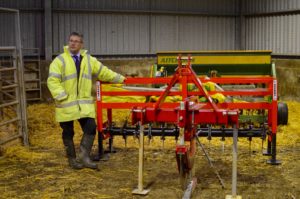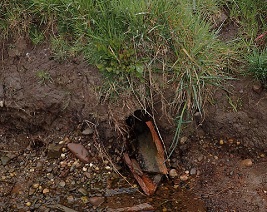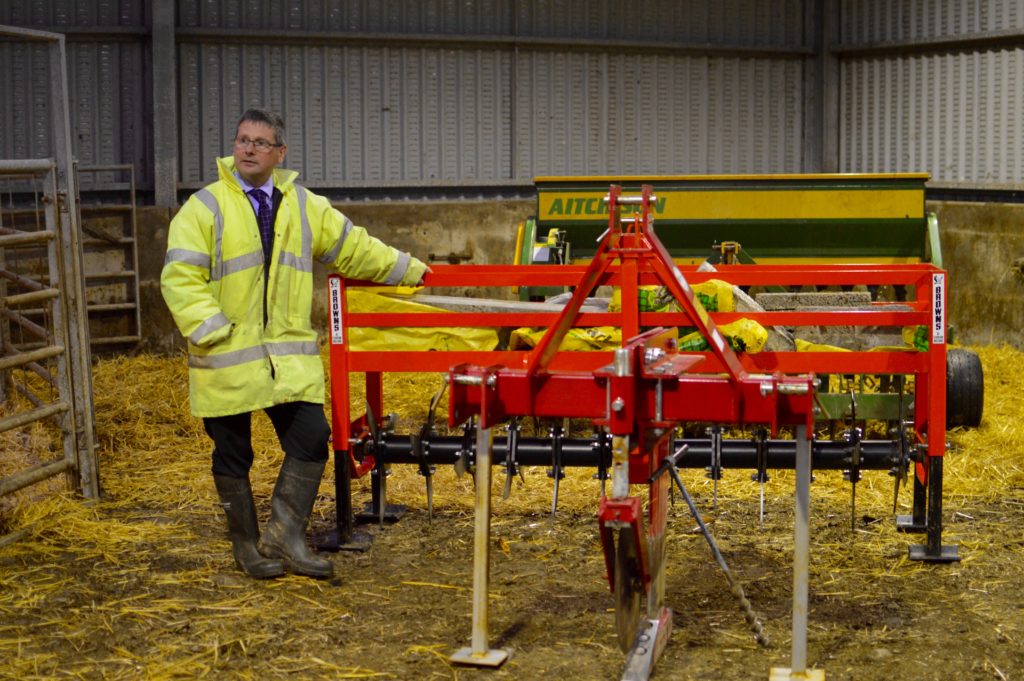Skye Soil & Nutrient Network: 2nd Meeting – Event Summary
28 September 2017This meeting followed up many of the concerns discussed in the first meeting of the Skye Soil & Nutrient Network group.
Before this meeting was held Douglas Priest SAC woodland specialist visited Waternish Farm to assess the woodland. We reported back some of his findings at the meeting and also had information about the different trees which attendees may want to plant on their own crofts and farms.
Waternish farm has a locally rare mature mixed broadleaved woodland. There is a lack of younger specimens within the wood due to grazing pressure from both domestic and wild herbivores but this does not detract from the beauty and feel of the place. This provision of shelter has a number of benefits to the surrounding areas, be these; shelter for livestock, lowered windspeed reducing the loss of soil following ploughing and also a physical screen for the pond and outbuilding within the woodland. This wood also creates habitat for a host of pollinators and bird species.
In terms of management options for the main area of woodland (mentioned above) it may be possible to access grant funding in order to carry out small scale tree felling (individual trees) to create and open planting position in which to plant a more diverse range of species. This restructuring work would also allow for the age class to be diversified as well which will prolong the life of the wood, as well as altering the fauna which would use the woodland.
Elsewhere on Waternish there is a mix of established riparian woodland strips and also more recent woodland creation areas. These riparian woodlands are great for a number of reasons; a reduction in silt entering watercourses (which results in increased water quality), increased bank stability via the tree roots and lastly a physical barrier to help control livestock movements and reduce the effects of poaching. These woodland areas have a mix of species including Scots Pine, Common Alder, Willow and Hawthorn, this mix of species helps during establishment as some species fare better in exposed, coastal conditions and once these have established they can create an improved habitat for less hardy species.
This meeting followed up many of the concerns discussed in the first meeting. Was the late cutting of silage having a negative impact on compaction of the soil? We tested two differen t types of equipment and discussed which was better as well as timing for operations.
t types of equipment and discussed which was better as well as timing for operations.
Available to view at the event was a grass slitter (for alleviating compaction at a depth of 25 -150mm in grassland) & a sub-soiler (for use to alleviate compaction at a depth of 300 – 500mm on grassland or arable ground). We are grateful to MacLaren Tractors Dingwall and Ian Duncan Feorlig for providing the equipment for the demonstration.
Gavin Elrick also went over the drainage plan he made for a wet corner of a field that gets a lot of traffic so is a priority.
Gavin gave 10 helpful drainage Points to note:
- Clear ditch’s of excess vegetation and silt

- Clear pipe drain outfalls and culverts
- Trim back trees near ditch’s
- Where a pipe passes near to trees or hedges make sure the pipe is sealed for 5 m either side
- When installing pipes make sure pipe is deep enough to pick up any identified spring water
- Where passing through areas of impermeable soil use gravel back fill (20-40 mm diameter washed gravel or clean stone)
- Use good quality pipes and connectors as the drains will be installed for a long time 30 to 60 years life span.
- Where the pipe discharges to the ditch use a purpose built headwall or build using local stone to keep the outlet firm and identifiable
- At culvert outlets put large stones in the base of the ditch to prevent erosion.
- When planning for drainage allow enough capacity in the pipe sizes to allow future expansion for all areas the pipe may drain when the budget is available.
Indoors David Lawson discussed the slow release fertiliser trial. FYM samples provided by the community group were discussed and the importance of sulphur was discussed. It is likely that if you are not applying FYM then using a fertiliser with sulphur will prove beneficial.
Waternish Farm is one of 12 Soil & Nutrient Network host farms across Scotland. These farms are taking a ‘before and after’ look at how to protect and improve farm soils and make best use of both organic and inorganic fertilisers, saving money, benefitting yields and improving farm efficiency and resilience. Read the Waternish Farm Case Study & catch up with what happened during the first meeting here.
Information on other and previous host farms can be found on the Farming & Water Scotland webpage.
- Valuing Your Soils – Practical Guidance for Scottish Farmers
- This brochure includes useful information about Scotland's agricultural soils and practical advice outlining the upfront financial savings and business benefits of better soil management and the efficient use of resources. Action and problem-specific 'field-sheets' are designed for busy farmers with limited time for reading.
- Topics: Soils, Climate Change, Water Management and Crops and Soils
- Visual Evaluation of Soil Structure (VESS) Score Chart
- This is a downloadable copy of the Visual Evaluation of Soil Structure (VESS) score chart for use in-field.
- Topics: Soils
- Practical Guide: Farm Woodlands for Shelter
- This Practical Guide looks at opportunities for improving shelter on the farm by the presence of woodlands.
- Topics: Climate Change
- Farming For A Better Climate: Practical Guide – Field Drainage
- Topics: Soils and Water Management
- Farming For A Better Climate: Practical Guide – Alleviating Soil Compaction
- This Practical Guide gives some ideas on how to alleviate soil compaction.
- Topics: Soils
- Farming For A Better Climate: Practical Guide – Improving Soil Quality
- This Practical Guide concentrates on how we can improve soil quality to help us to adapt to climate change.
- Topics: Soils
- Farming For A Better Climate: Practical Guide – Soil Management
- Topics: Soils
- Practical Guide: Soil sampling I – How to take a soil sample
- This practical guide details what is required to take a soil sample for analysis that is representative of the area sampled.
- Topics: Soils, Climate Change and Water Management
- Practical Guide: Soil sampling II – Benefits to your business
- This practical guide details how soil sampling can benefit businesses by increasing productivity and create efficiencies on fertiliser inputs through better nutrient planning.
- Topics: Soils, Climate Change and Water Management
- Practical Guide: Tyre Selection & Management
- This practical guide explains how to reduce soil damage, improve fuel usage and reduce overall green house gas emissions by selecting the correct tyre size, type and pressure.
- Topics: Climate Change
- Soil & Nutrient Network – Case Study: Waternish Farm, Skye
- Soil & Nutrient Network - helping farmers improve soils structure and nutrient management. This case study provides details of the Skye Soil & Nutrient Network Farm - Waternish Farm.
- Topics: Soils
- Technical Note (TN656): Soil Information, Texture & Liming Recommendations
- • Web based access to information on your soils on your farm is described. • Soil texture classes of mineral soils are described and identified by hand texturing. • Liming recommendations for different soils and managements are tabulated.
- Topics: Soils
- Technical Note (TN668): Managing Soil Phosphorus
- Efficient soil P management is challenging due to the varying ability of soils to mediate and regulate plant available forms of P. Farmers and land managers in Scotland are now able to access farm level information about their soils making it possible to provide more accurate P management advice.
- Topics: Crops and Soils
- Technical Note (TN685): Sulphur Recommendations for Crops
- This technical note examines the use of sulphur (S) for crops, and outlines sulphur deficiency, recommendations for use and availability of nutrients in organic fertilisers.
Sign up to the FAS newsletter
Receive updates on news, events and publications from Scotland’s Farm Advisory Service


